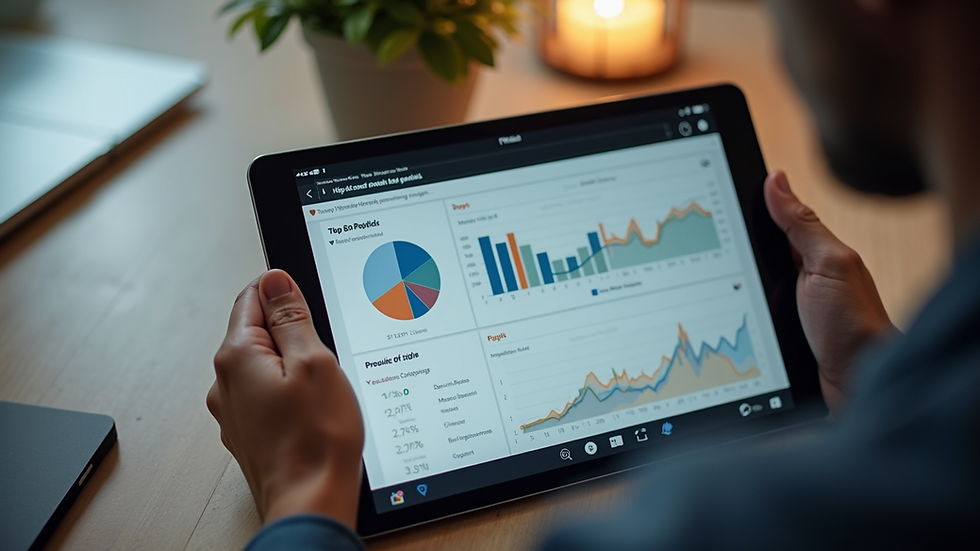Boost Your Blog Traffic with These Proven Strategies
- PerOla Hammar 陈家悦
- Aug 11
- 3 min read
Growing a blog audience can feel like a daunting task. With millions of blogs competing for attention, standing out requires more than just great content. It demands smart strategies, consistent effort, and a clear understanding of what drives traffic. This guide will walk you through practical, actionable steps to increase your blog audience effectively.
How to Increase Blog Audience with Smart Content Planning
Creating content that resonates with your readers is the foundation of any successful blog. To increase blog audience, start by understanding what your target readers want. Use tools like Google Trends, Answer the Public, or keyword research platforms to discover popular topics in your niche.
Tips for effective content planning:
Focus on evergreen topics: These are subjects that remain relevant over time, ensuring steady traffic.
Create detailed guides and how-tos: In-depth content tends to perform well in search engines and keeps readers engaged.
Use a content calendar: Plan your posts ahead to maintain consistency and cover a variety of topics.
For example, if you run a travel blog, instead of just posting "Top 10 Destinations," create detailed guides like "How to Travel Europe on a Budget" or "Step-by-Step Guide to Backpacking Southeast Asia."

Effective SEO Techniques to Increase Blog Audience
Search Engine Optimization (SEO) is crucial for attracting organic traffic. Optimizing your blog posts helps search engines understand your content and rank it higher in search results.
Key SEO strategies include:
Keyword Optimization: Use relevant keywords naturally in titles, headers, and throughout the content.
Meta Descriptions: Write compelling meta descriptions to improve click-through rates.
Internal Linking: Link to other relevant posts on your blog to keep visitors engaged longer.
Mobile Optimization: Ensure your blog is mobile-friendly since most users browse on smartphones.
Fast Loading Speed: Optimize images and use caching to reduce page load times.
Additionally, using descriptive alt text for images improves accessibility and SEO. For instance, instead of generic alt text like "image1," use something like "Close-up view of a laptop showing SEO analytics."

Why is My Blog Not Getting Traffic?
If your blog isn’t attracting visitors, it’s important to diagnose the problem before trying new strategies. Here are some common reasons why blogs struggle with traffic:
Lack of Promotion: Simply publishing content is not enough. You need to actively share your posts on social media, forums, and relevant communities.
Poor SEO Practices: Without proper keyword research and optimization, your posts may not rank well.
Inconsistent Posting: Irregular updates can cause readers to lose interest and search engines to lower your ranking.
Unclear Target Audience: If your content doesn’t address a specific audience’s needs, it won’t attract loyal readers.
Low-Quality Content: Thin or poorly written posts fail to engage visitors or encourage sharing.
To fix these issues, start by auditing your blog. Check your analytics to see which posts perform best and which don’t. Improve underperforming content by adding more value, updating information, and optimizing for SEO.

Leveraging Social Media and Communities to Increase Blog Audience
Social media platforms and online communities are powerful tools to grow your blog audience. Sharing your content where your potential readers hang out can drive significant traffic.
Best practices for social media promotion:
Choose the right platforms: Focus on where your audience spends time, whether it’s Facebook, Twitter, Instagram, LinkedIn, or niche forums.
Engage, don’t just broadcast: Respond to comments, join conversations, and build relationships.
Use visuals: Posts with images or videos get more engagement.
Schedule posts: Use tools like Buffer or Hootsuite to maintain a consistent presence.
Participating in online communities like Reddit, Quora, or niche-specific forums can also help. Provide helpful answers and link back to your blog when relevant, but avoid spamming.
Email Marketing: A Direct Way to Increase Blog Audience
Building an email list is one of the most effective ways to grow your blog audience. Unlike social media, email gives you direct access to your readers.
Steps to build and use an email list:
Offer a lead magnet: Provide a free resource like an ebook, checklist, or course in exchange for email sign-ups.
Use a reliable email service: Platforms like Mailchimp or ConvertKit help manage your list and automate campaigns.
Send regular newsletters: Share your latest posts, exclusive content, and personalized messages.
Segment your list: Tailor emails based on reader interests to increase engagement.
Email marketing nurtures your audience and encourages repeat visits, which is essential for long-term blog growth.
Final Thoughts on Growing Your Blog Audience
Increasing your blog audience takes time and effort, but the rewards are worth it. By combining smart content planning, SEO, social media engagement, and email marketing, you create a powerful system to attract and retain readers.
Remember, to truly boost blog traffic, focus on delivering value consistently and building genuine connections with your audience. Keep experimenting, analyzing your results, and refining your strategies to see continuous growth.
Start implementing these proven strategies today and watch your blog audience expand steadily!




Comments